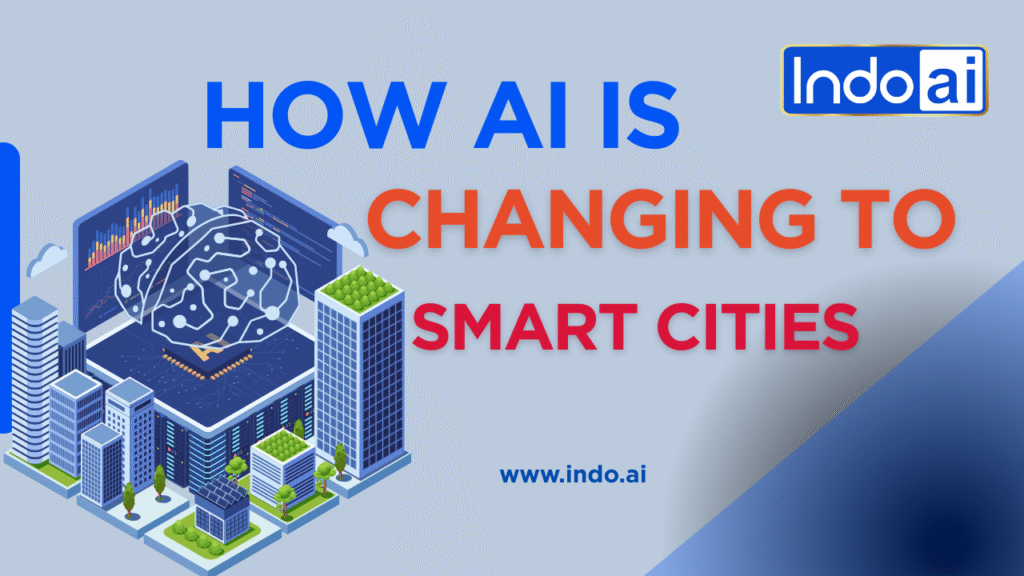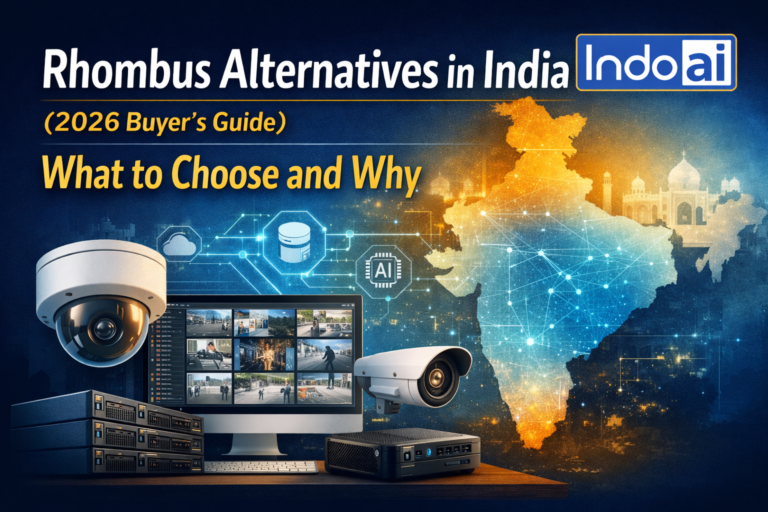
Introduction
Stretching rapidly, cities are on an unprecedented path of growth. More than two-thirds Worlds population will be living in urban areas by 2050. With this growth comes significant possibility as well as problems – everything from traffic congestion and pollution to waste management and public safety. Cities and their leaders, as well as companies and innovators alike, are looking to smart cities-/cities of the future(s) – to help cities systematically tackle many of these 21st century issues. In these smart cities, powerful technology becoming ubiquitous (AI, IoT, etc.) are being used in ways that are safer, efficient, and more sustainable!
Smart cities are not merely about putting a few sensors in place and “collecting” data. It is about applying intelligence at the edge to make decisions in real-time that enhance the lives of citizens. IndoAI is an Indian AI leader delivering edge computing solutions that are at the forefront of this transformation. IndoAI, by providing AI cameras and IoT systems that operate at the edge without relying on cloud infrastructure is ushering in a new way of how cities can become smarter, safer, and more efficient.
What Makes a City “Smart”?
A smart city uses sensor data and AI to monitor infrastructure, improve services, and enhance life for urban dwellers. Instead of a conventional city’s reliance on human monitoring and analysis of regular monitoring methods for infrastructure, smart cities use real-time information to recognize and respond to a condition that is emergent.
Take for instance a traffic light that operates with AI. The traffic light can adjust itself to lower traffic congestion automatically.
Take for example garbage cans. Garbage cans that let authorities know when the can is full. It will help ensure garbage doesn’t overflow and create an unsanitary situation. Cameras that immediately see fire or see suspicious activity let law enforcement or emergency staff respond immediately.
AI is the core of our ecosystem. If we did not have AI, sensors and cameras would only be able to capture data and not turn that data into intelligence. AI allows us to turn unstructured data into actionable decisions and do that in real time while protecting both operational efficiency and privacy.
The Role of AI in Smart Cities
AI transforms cities across several key dimensions:
Urban Safety and Security
The world of city planning considers public safety a priority. AI-based cameras can recognize abnormal behavior, identify accidents and even recognize fire and smoke before a human can identify it. Real-time notifications enable first responders to act quickly, and helps prevent something small from cascading into a more disastrous situation.
Read More: AI Cameras for Rural Applications: Enhancing Safety, Efficiency, and Connectivity
Traffic and Mobility
AI systems reduce congestion on road networks through congestion analysis, vehicle re-routing, and adjusting signal timings. Benefits include travel time savings, reduced fuel consumption, and improved air quality. Smart cameras survey road violations to improve safe driving behaviours.
Read More: IndoAI Vehicle Number Plate Detection: Traffic Management
Read Also: AI Face Recognition in Traffic Systems
Waste and Resource Management
Artificial intelligence sensors monitor the waste levels in bins, water use in pipelines, and real-time energy use in city grids. This information means resources can be managed sustainably and better informed on reducing waste and supporting greener initiatives.
Healthcare and Emergency Response
Hospitals in smart cities can take advantage of AI for patient flow, ambulance route management, and public-health fact-finding. In emergencies, AI can facilitate rescue operations with navigation (e.g., best routes to avoid perils, detecting hazardous conditions).
Read More: AI Cameras in Healthcare: Revolutionizing Patient Care
Environmental Monitoring
AI cameras and Internet of Things sensors can either monitor air quality, detect illegal emissions, or track deforestation or land misuse. Insight into such topics will allow policymakers to develop evidence-based decision-making policies or sustainable economic growth.
The Need for Edge AI in Smart Cities
Artificial Intelligence may be the brain of smart cities, but the timeliness of decision making is equally important. Conventional cloud-based ecosystems depend on data traveling back and forth with our devices and the central server. These systems have inherent delays that may be unacceptable in an emergency such as an accident, fire, or crime.
Read Also: How Does Edge AI Work? Real-Time Intelligence at the Edge
This is where edge AI comes in. Edge AI enables devices like cameras to process data locally, without sending everything to the cloud. The advantages are clear:
- Instant Response: Alerts are generated in milliseconds.
- Reduced Bandwidth: Only essential data or event summaries are transmitted.
- Enhanced Privacy: Sensitive video and information remain on-site, reducing risks of breaches.
By combining real-time decision-making with high reliability, edge AI has become the backbone of next-generation smart cities.
IndoAI: Driving Smart Cities Forward
The success story in this space is IndoAI, an India-based company that designs edge AI cameras and IoT systems. IndoAI offers an ecosystem of AI-enabled cameras that can run many different apps at once.
These advances in AI technology are important for smart cities as we discover new ways to address diverse challenges for scalable and flexible solutions. City managers will be able to deploy AI models in a city the same way we can install apps on our smartphones. This new way of deploying AI in a city is called “Appization” because one camera can do many things like fire detection, crowd counting, road congestion, environmental monitoring, and many more.
Why IndoAI Excels in Smart Cities
- Versatility: IndoAI cameras can detect fire, smoke, safety violations, intrusions, and even measure traffic density—all from the same device.
- Reliability: With on-device AI processing, they continue working even during internet disruptions—an essential feature in busy cityscapes.
- Scalability: IndoAI’s model-based architecture allows cities to start small and expand easily, adding new AI capabilities over time without replacing hardware.
- Privacy by Design: Since most processing happens locally, sensitive data never leaves the city’s boundaries, ensuring compliance with privacy laws.
- Proven Impact: IndoAI cameras are already deployed in industries, schools, and public institutions, demonstrating their effectiveness in real-world conditions.
Practical Applications of IndoAI in Smart Cities
Visualize a city utilizing IndoAI’s technology. Cameras mounted at traffic intersections identify congestion and adjust signal timing in real-time. Simultaneously capturing these events, the same devices detect accidents and notify first responders right away. IndoAI cameras protect crowded markets by anticipating potential fire hazards and quickly identifying them for a faster evacuation. In areas with cultural heritage sites, IndoAI cameras will help monitor visitor conditions and monitor for vandalism through smart video analytics.
With the dual-purpose design of IndoAI technology, municipalities will utilize less devices, make fewer total purchases, and will be more efficient. Their ecosystem is compatible with apps and dashboards thus the feedback from all IndoAI devices is readily available for decision makers to prospectively utilize by pulling city-wide real-time data and alerts.
The Economic and Social Value of Smart Cities
Investing in smart cities is not just about adopting advanced technology—it is about creating long-term value for both governments and citizens.
- Economic Growth: Smart infrastructure attracts investment, promotes entrepreneurship, and creates new job opportunities in the tech-driven economy.
- Citizen Well-being: Reduced pollution, safer streets, and efficient services directly improve quality of life.
- Sustainability: Intelligent monitoring reduces energy use, minimizes waste, and helps cities achieve climate goals.
- Cost Efficiency: Automated systems reduce manual oversight and optimize resource allocation, leading to long-term savings for municipalities.
Challenges and the Path Forward
While new smart cities are an exciting prospect, there are always challenges associated with the construction of new smart cities. These include; high up-front costs, data-security and privacy concerns to legislative issues that may provide barriers to slowing implementation efforts. But challenges are not insurmountable. As long as city planners can carefully plan, maintain a phased implementation rollout, and find partnerships with innovative organizations like IndoAI, smart cities can begin solutions towards smarter living within their current infrastructure, gradually creating the infrastructure needed for a smarter city.
Furthermore, governments need to put more serious efforts in discovering ways to educate their populations on digital literacy, so that citizens and city workers will be capable of using and trusting the smart systems being created in their cities. As regulations are being formed and adopted, they should focus on interest and investments in transparency, AI and data accountability, and ethical use of AI algorithms, while also working towards implementing the global regulations on responsible innovation.
Conclusion
The concept of living in smart cities is the future of urbanization – cities that not only grow but evolve intelligently. By leveraging AI and edge computing, smart cities can address critical challenges like safety, sustainability, and efficiency.
Companies like IndoAI are leaders in this transformation. By integrating edge AI cameras, scalable architecture, and a track record of innovation, IndoAI is showing how technology can build smarter, safer, responsive, and sustainable cities.



